What Is Dabbing? If you’re curious about cannabis concentrates and their consumption methods, WHAT.EDU.VN provides a comprehensive guide. Dabbing involves vaporizing these potent extracts, offering a unique experience with enhanced flavors and effects. Learn about the nuances of dabbing, including the equipment needed and different types of concentrates like shatter, wax, and rosin. Unlock the secrets to enjoying dabs safely and effectively.
1. Understanding Dabbing: What is a Dab?
Dabbing refers to the process of vaporizing cannabis concentrates for consumption. A “dab” itself is a dose of cannabis concentrate, a potent form of cannabis created by extracting cannabinoids like THC and CBD, along with terpenes and other desirable compounds, from the cannabis plant. These concentrates come in various forms and textures, each offering a unique experience.
1.1 Types of Cannabis Concentrates (Dabs)
Dabs come in a variety of forms, each with distinct characteristics and consistencies. Here are some of the most common types:
- Shatter: A translucent, glass-like concentrate that is known for its brittle texture. It’s typically amber in color and can be easily broken into smaller pieces.
- Wax: A soft, opaque concentrate with a wax-like consistency. It can range in color from light yellow to dark brown and is often easier to handle than shatter.
- Crumble: A dry, crumbly concentrate that is often more potent than wax. It’s typically yellow or light brown in color and has a slightly airy texture.
- Budder/Batter: Similar to wax but with a creamier, butter-like consistency. It’s typically light yellow or off-white in color and is known for its smooth texture.
- Rosin: A solventless concentrate made by applying heat and pressure to cannabis flower or kief. It’s typically amber in color and has a terpene-rich flavor profile.
- Live Resin: A concentrate made from fresh, flash-frozen cannabis flower. This process preserves the terpenes, resulting in a concentrate with a more complex and aromatic flavor profile.
- Sauce: A viscous, high-terpene extract with a syrupy consistency, often containing crystalline structures known as “diamonds”.
1.2 The Dabbing Process Explained
The dabbing process involves heating a surface, typically a nail made of quartz, titanium, or ceramic, to a high temperature using a torch or an electronic nail (e-nail). Once the nail is hot, a small amount of concentrate is applied to the surface using a dabber, a specialized tool for handling concentrates. The heat instantly vaporizes the concentrate, producing a potent vapor that is inhaled through a dab rig, a specialized water pipe designed for dabbing.
2. Dabbing vs. Smoking: Key Differences
Dabbing and smoking are two distinct methods of consuming cannabis, each with its own set of characteristics, advantages, and disadvantages. Understanding the differences between these methods can help you make an informed decision about which one is right for you.
| Feature | Dabbing | Smoking |
|---|---|---|
| Potency | Significantly higher THC/CBD content (60-90%+) | Lower THC/CBD content (10-25%) |
| Flavor | More pronounced and nuanced terpene profile | Can be masked by combustion byproducts |
| Combustion | Vaporization; no burning of plant matter | Combustion; burning of plant matter, producing smoke |
| Equipment | Dab rig, nail, torch/e-nail, dabber, carb cap | Rolling papers/blunt wraps, pipe/bong, lighter |
| Onset Time | Very rapid; effects felt almost immediately | Relatively quick; effects felt within minutes |
| Discreetness | Less discreet due to specialized equipment and torch use | More discreet with portable options like pipes and vape pens |
| Cost | Higher initial investment for equipment; concentrates can be more expensive | Lower initial investment; flower is generally more affordable than concentrates |
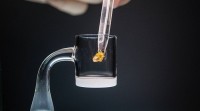
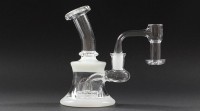
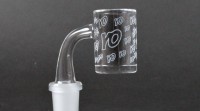
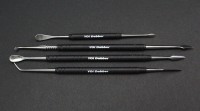
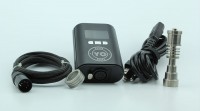
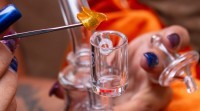
2.1 Potency and Effects
One of the most significant differences between dabbing and smoking is the potency of the product being consumed. Cannabis concentrates used in dabbing typically contain significantly higher levels of THC (tetrahydrocannabinol), the primary psychoactive compound in cannabis, compared to traditional cannabis flower. Concentrates can range from 60% to 90% THC or even higher, while cannabis flower typically contains between 10% and 25% THC. This higher potency translates to a more intense and immediate psychoactive experience.
The effects of dabbing are often described as more pronounced and faster-acting than those of smoking. Users may experience a stronger sense of euphoria, relaxation, and altered perception. However, due to the high potency, dabbing can also be more likely to cause anxiety, paranoia, or other adverse effects, especially for those who are new to cannabis or have a low tolerance.
2.2 Flavor and Aroma
Dabbing can offer a more flavorful and aromatic experience compared to smoking. This is because the vaporization process preserves the terpenes, the aromatic compounds responsible for the distinct smells and flavors of different cannabis strains. When cannabis is smoked, the combustion process can destroy some of these terpenes, resulting in a less nuanced flavor profile.
Concentrates, especially those made using methods like live resin extraction, can retain a high concentration of terpenes, resulting in a more intense and complex flavor experience. Users often describe dabbing as providing a cleaner, purer taste compared to smoking, as there are no combustion byproducts to mask the flavor.
2.3 Health Considerations
Dabbing and smoking both carry potential health risks. Smoking involves the combustion of plant matter, which produces smoke containing harmful chemicals and carcinogens. These substances can irritate the lungs and respiratory system, potentially leading to chronic bronchitis, coughing, and an increased risk of respiratory infections.
Dabbing, on the other hand, avoids the combustion of plant matter, which can reduce the exposure to some of the harmful chemicals found in smoke. However, dabbing also involves heating concentrates to high temperatures, which can produce potentially harmful byproducts like methacrolein and benzene. The long-term health effects of dabbing are still being studied, and more research is needed to fully understand the potential risks.
It’s important to note that both dabbing and smoking can affect cardiovascular health. Cannabis use can increase heart rate and blood pressure, which may be concerning for individuals with pre-existing heart conditions.
2.4 Equipment and Cost
Dabbing requires specialized equipment, including a dab rig, nail, torch or e-nail, dabber, and carb cap. The initial investment for this equipment can be higher than that of smoking paraphernalia like rolling papers or a pipe. However, the long-term cost can vary depending on consumption habits.
Concentrates are generally more expensive per gram than cannabis flower. However, due to their higher potency, users may consume smaller amounts of concentrates to achieve the desired effects, potentially offsetting the higher cost per gram.
2.5 Discretion
Smoking cannabis is often associated with a strong, distinctive odor that can be easily detected. This can make smoking less discreet than other consumption methods.
Dabbing can also produce a noticeable odor, although it may be less pungent than that of smoking. The use of a torch or e-nail can also attract attention, making dabbing less discreet in certain situations. However, portable vaporizers designed for concentrates can offer a more discreet option for consuming dabs on the go.
3. Essential Dabbing Equipment: A Comprehensive Guide
To properly dab, you’ll need a few essential tools. Here’s a breakdown of each component:
3.1 The Dab Rig: Your Primary Tool
A dab rig is a specialized water pipe designed specifically for vaporizing concentrates. It is similar in appearance to a traditional bong, but with a few key differences. Dab rigs are typically smaller than bongs, as vapor requires less filtration than smoke. This smaller size also helps to preserve the flavor and aroma of the concentrates.
The most important feature of a dab rig is the joint, which is the opening where the nail is inserted. Dab rigs typically have either a male or female joint, and the nail must be the opposite gender to fit properly. The most common joint sizes are 10mm, 14mm, and 18mm.
3.2 The Nail (Banger): Where the Magic Happens
The nail, also known as a banger, is the surface that is heated to vaporize the concentrate. Nails can be made from a variety of materials, including quartz, titanium, ceramic, and glass. Quartz nails are the most popular choice due to their excellent heat retention, clean flavor, and relatively low cost. Titanium nails are extremely durable and heat up quickly, but they can sometimes impart a metallic taste to the vapor. Ceramic nails offer good heat retention and a neutral flavor, but they are more prone to cracking than quartz or titanium nails.
3.3 The Dabber: Your Precision Instrument
A dabber is a tool used to handle and apply concentrates to the heated nail. Dabbers come in a variety of shapes and sizes, and they are typically made from stainless steel, glass, or titanium. The shape of the dabber tip can affect how easily the concentrate vaporizes, with some shapes being better suited for certain types of concentrates.
3.4 The Carb Cap: Controlling Airflow and Vaporization
A carb cap is an accessory that is placed over the nail after the concentrate has been applied. Carb caps restrict airflow, which helps to lower the temperature required for vaporization and allows for more efficient vaporization of the concentrate. Carb caps also help to trap the vapor, preventing it from escaping and maximizing the amount that is inhaled.
3.5 The Torch or e-Nail: Your Heat Source
A torch is used to heat the nail to the desired temperature. Butane torches are the most common type of torch used for dabbing, as they provide a consistent and controllable flame. Electronic nails (e-nails) are an alternative to torches that provide a more precise and consistent temperature. E-nails consist of a heating coil that wraps around the nail and a control box that allows you to set the desired temperature.
3.6 Optional Accessories
- Terp Pearls: Small beads made of quartz or ceramic that are placed inside the nail to help distribute heat and vaporize concentrates more evenly.
- Quartz Inserts: Small quartz dishes that are placed inside the nail to keep it clean and prevent chazzing (the buildup of residue).
- Dab Mats: Silicone mats that protect your surfaces from spills and heat.
4. Dabbing Techniques: A Step-by-Step Guide
Now that you have the necessary equipment, let’s walk through the dabbing process step-by-step.
- Prepare Your Rig: Fill your dab rig with water, ensuring that the water level is high enough to provide adequate filtration but not so high that it splashes into your mouth.
- Heat the Nail: Using a torch, heat the nail until it is red hot. The heating time will vary depending on the type of nail and the torch being used. As a general guideline, heat the nail for 30-60 seconds.
- Cool Down: Allow the nail to cool down for 10-60 seconds. The cool-down time will also vary depending on the type of nail and your personal preference. Cooling down the nail is important to prevent burning the concentrate and to preserve the flavor and aroma of the terpenes.
- Load the Dabber: Use your dabber to scoop up a small amount of concentrate. Start with a small amount, as concentrates are very potent, and you can always take another dab if needed.
- Apply the Concentrate: Place the tip of the dabber inside the nail and gently rotate it to apply the concentrate. Inhale slowly and steadily as the concentrate vaporizes.
- Cap the Nail: Place the carb cap over the nail to restrict airflow and trap the vapor. Continue inhaling slowly and steadily.
- Exhale and Enjoy: Exhale the vapor and enjoy the effects.
4.1 Cold Start Dabbing
Cold start dabbing, also known as reverse dabbing, is a dabbing technique that involves placing the concentrate in the nail before heating it. This method is said to preserve more of the terpenes and provide a smoother, more flavorful experience.
To cold start dab, simply place a small amount of concentrate in the nail, then heat the nail gently with a torch until the concentrate begins to vaporize. Cap the nail and inhale slowly and steadily.
4.2 Low-Temperature Dabbing
Low-temperature dabbing involves heating the nail to a lower temperature than traditional dabbing. This method is said to preserve more of the terpenes and provide a smoother, more flavorful experience. Low-temperature dabbing can be achieved by using an e-nail or by carefully timing the cool-down period after heating the nail with a torch.
4.3 Cleaning Your Dab Rig
Regular cleaning is essential to maintain the flavor and performance of your dab rig. To clean your dab rig, start by emptying the water and rinsing it with warm water. Then, use a cleaning solution designed for glass pipes to remove any residue. You can also use isopropyl alcohol and salt to clean your dab rig. After cleaning, rinse your dab rig thoroughly with warm water and allow it to dry completely before using it again.
5. Safety and Considerations When Dabbing
Dabbing can be a potent and enjoyable way to consume cannabis, but it’s important to be aware of the potential risks and to take precautions to ensure your safety.
5.1 Start Low and Go Slow
Concentrates are significantly more potent than cannabis flower, so it’s important to start with a small amount and increase your dosage gradually. Overconsumption of concentrates can lead to anxiety, paranoia, and other unpleasant side effects.
5.2 Use Proper Ventilation
Dabbing can produce fumes and vapors that can be irritating to the lungs. It’s important to dab in a well-ventilated area to minimize your exposure to these substances.
5.3 Be Careful with the Torch
Torches produce a very hot flame that can cause burns if not handled carefully. Always point the torch away from yourself and others, and never leave a lit torch unattended.
5.4 Store Concentrates Safely
Store your concentrates in a cool, dark place away from children and pets. Concentrates can be easily mistaken for candy or other edible products, so it’s important to keep them out of reach of those who may not understand their potency.
5.5 Know Your Limits
Dabbing can be a very intense experience, so it’s important to know your limits and to consume responsibly. If you’re feeling overwhelmed or uncomfortable, stop dabbing and take a break.
6. Concentrate Extraction Methods: A Closer Look
Concentrates are categorized by the extraction methods used to create them. Here are some common techniques:
6.1 Solvent-Based Extraction
Solvent-based extraction methods use solvents like butane, propane, or CO2 to separate the cannabinoids and terpenes from the cannabis plant material. These methods are efficient and can produce high yields, but they also carry the risk of residual solvents remaining in the final product.
- Butane Hash Oil (BHO): BHO is one of the most common types of solvent-based concentrates. It is made by using butane to extract the cannabinoids and terpenes from the cannabis plant material. BHO can come in a variety of forms, including shatter, wax, crumble, and budder.
- Propane Hash Oil (PHO): PHO is similar to BHO, but it uses propane as the solvent. PHO is said to have a slightly different flavor profile than BHO.
- CO2 Oil: CO2 oil is made by using supercritical CO2 to extract the cannabinoids and terpenes from the cannabis plant material. CO2 oil is considered to be a cleaner and safer option than BHO or PHO, as CO2 is a non-toxic solvent.
6.2 Solventless Extraction
Solventless extraction methods use physical processes like heat, pressure, and agitation to separate the cannabinoids and terpenes from the cannabis plant material. These methods are considered to be safer than solvent-based extraction methods, as they do not involve the use of potentially harmful solvents.
- Rosin: Rosin is made by applying heat and pressure to cannabis flower or kief. The heat and pressure cause the cannabinoids and terpenes to be expressed from the plant material. Rosin is a potent and flavorful concentrate that is easy to make at home.
- Ice Water Hash (Bubble Hash): Ice water hash is made by agitating cannabis plant material in ice water. The cold temperature causes the trichomes (the resin glands that contain the cannabinoids and terpenes) to become brittle and break off from the plant material. The trichomes are then filtered out of the water using a series of screens. Ice water hash is a potent and flavorful concentrate that can be used for dabbing or smoking.
7. Frequently Asked Questions About Dabbing
Here are some frequently asked questions about dabbing:
| Question | Answer |
|---|---|
| What is the ideal temperature for dabbing? | The ideal temperature for dabbing varies depending on the type of concentrate and your personal preference. However, a good starting point is between 350°F and 450°F. |
| How do I clean my dab rig? | To clean your dab rig, start by emptying the water and rinsing it with warm water. Then, use a cleaning solution designed for glass pipes to remove any residue. You can also use isopropyl alcohol and salt to clean your dab rig. After cleaning, rinse your dab rig thoroughly with warm water and allow it to dry completely before using it again. |
| Is dabbing safe? | Dabbing can be safe if done responsibly and with the proper equipment. It’s important to start with a low dose, use proper ventilation, and be careful with the torch. |
| What are the benefits of dabbing? | The benefits of dabbing include a more potent and flavorful experience, faster onset of effects, and reduced exposure to harmful chemicals compared to smoking. |
| What are the risks of dabbing? | The risks of dabbing include overconsumption, burns from the torch, and exposure to potentially harmful byproducts. |
| Can I dab CBD concentrates? | Yes, you can dab CBD concentrates. Dabbing CBD concentrates can provide a fast and effective way to experience the therapeutic benefits of CBD without the psychoactive effects of THC. |
| How long do the effects of dabbing last? | The duration of the effects of dabbing can vary depending on the potency of the concentrate, your individual tolerance, and other factors. However, the effects of dabbing typically last longer than those of smoking, often lasting for several hours. |
| Can dabbing cause a positive drug test? | Yes, dabbing can cause a positive drug test for THC. Even if you are dabbing CBD concentrates that contain only trace amounts of THC, it is still possible to test positive for THC due to the sensitivity of some drug tests. |
| What is the difference between dabbing and vaping? | Dabbing involves vaporizing concentrates on a heated surface, while vaping involves heating a liquid or solid material to create a vapor that is inhaled. Vaping is often more discreet and portable than dabbing, but dabbing can provide a more potent and flavorful experience. |
| Where can I learn more about dabbing? | You can learn more about dabbing by visiting reputable online resources, such as WHAT.EDU.VN, or by consulting with experienced cannabis users. |
8. Dabbing: A Modern Cannabis Consumption Method
Dabbing represents a modern evolution in cannabis consumption, offering a potent, flavorful, and efficient way to experience the benefits of cannabis concentrates. While it requires some initial investment in equipment and a learning curve to master the technique, many users find that the enhanced experience is well worth the effort.
Remember to always prioritize safety, start with low doses, and consume responsibly. By following these guidelines, you can enjoy the benefits of dabbing while minimizing the potential risks.
9. Still Have Questions? Ask WHAT.EDU.VN!
Navigating the world of dabbing can be complex, but you don’t have to do it alone. At WHAT.EDU.VN, we’re dedicated to providing clear, reliable, and accessible information to answer all your burning questions about cannabis and dabbing. Whether you’re curious about different types of concentrates, troubleshooting your dabbing setup, or simply want to learn more about the science behind it all, we’re here to help.
Our team of experts is ready to provide you with the answers you need. We understand the challenges of finding trustworthy information, which is why we’re committed to delivering accurate and up-to-date content.
Don’t hesitate to reach out with your questions. We’re here to help you explore the world of dabbing with confidence and clarity. Visit WHAT.EDU.VN today and ask your question for free!
Contact Us:
Address: 888 Question City Plaza, Seattle, WA 98101, United States
WhatsApp: +1 (206) 555-7890
Website: WHAT.EDU.VN
We look forward to hearing from you and helping you on your dabbing journey.
10. Ready to Learn More?
Dabbing can seem intimidating at first, but with the right information and guidance, it can be a rewarding experience. WHAT.EDU.VN is your trusted resource for all things cannabis, providing you with the knowledge and support you need to explore the world of dabbing safely and confidently. Unlock a world of information and ask your questions for free on what.edu.vn!
